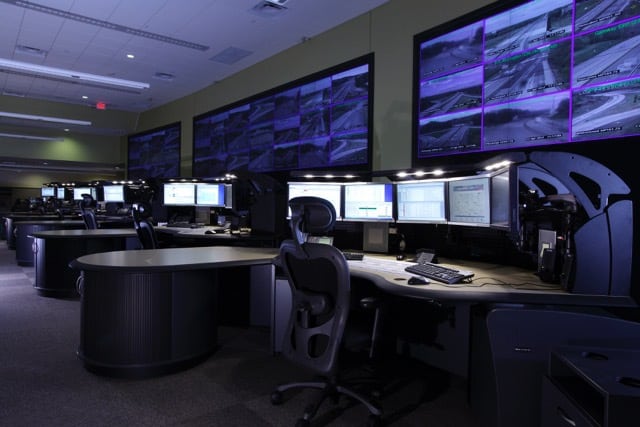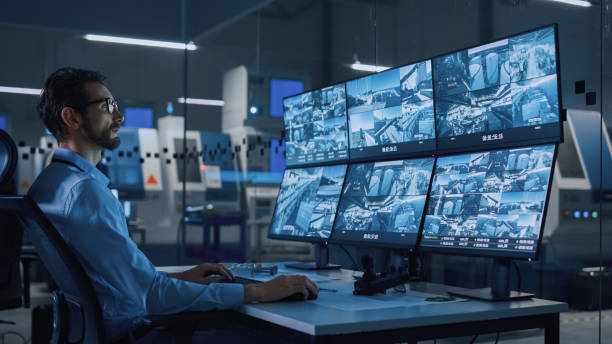Control rooms serve as the decision-making hubs for industries ranging from utilities and oil & gas to public safety. Their design directly affects operator performance and, in turn, the speed and accuracy of mission-critical responses.
To achieve a high level of performance, any control room design must focus on two core factors: efficiency and ergonomics. Efficiency reflects how well the workspace supports rapid, accurate, and continuous operations. Ergonomic design meaning, on the other hand, focuses on shaping the environment to fit the people who use it, reducing strain and sustaining focus.
When both elements are aligned, the control room becomes more than functional. It can then support daily performance and prepare teams to meet future demands.
Why Ergonomics Is Essential in 24/7 Environments
A control room’s primary goals are situational awareness and informed decision-making, both of which are constant demands in a 24/7 setting. However, ignoring ergonomics is one of the most common and costly mistakes.
When that happens, fatigue and discomfort erode awareness, slow decisions, and make safe operations harder to sustain. Ergonomic furniture and equipment counter those risks by supporting operators through long shifts and keeping performance steady around the clock.
The advantages that an ergonomic control room design brings to a 24/7 environment show up in several ways, including:
- Lower fatigue, allowing operators to stay alert to changing conditions
- Workstations that reduce strain, leading to faster and more accurate decisions
- A more comfortable setup that helps teams maintain safe and consistent operations
Key Features of Ergonomic Control Room Furniture
Well-designed, adjustable furniture reduces strain and enhances comfort, both of which helps operators stay focused through long shifts. The most important considerations fall into three areas: operator equipment, workspace setup, and overall layout.
Operator Equipment
People manning control room positions spend extended hours monitoring and responding to information. As such, adaptable furniture makes a direct difference in performance.
Common features of equipment that promote proper ergonomics include:
- Chairs with lumbar support, thick padding, and optional headrests or footrests
- Height-adjustable models that encourage posture changes to reduce strain
- Monitor arms that let personnel position screens at the correct height and angle
- Low-glare surfaces that preserve screen clarity under bright lighting.
In many cases, workers rely on a multi-monitor console to manage several data streams at once. Pairing these consoles with customized console configurations ensures that screens, keyboards, and controls align with their natural reach.
Comfort goes beyond seating and desk height, though. Temperature can be another source of distraction, which is why consoles with individual heating and cooling options such as adjustable ventilation or small radiant heaters help people stay comfortable through long shifts.
Lighting is just as important. Dimmable task lights reduce eye strain by giving operators control over brightness at their station without affecting coworkers. They also improve overall situational awareness by keeping work surfaces evenly lit and free of glare.
These adjustments improve comfort and focus, while additions like footrests and well-placed controls cut down on stretching and twisting that lead to strain. Together, they form the foundation of effective workstation design and help transform each position into an ergonomic command center capable of supporting reliable performance in demanding environments.
Workspace Setup
The environment around operators also shapes performance. Effective cable management keeps cords organized and out of sight, reducing clutter and supporting concentration. At the same time, adequate surface space ensures computers, monitors, and reference materials have room without crowding.
Durability is another important factor. Heavy-duty, mission-critical furniture supports high-value equipment while withstanding continuous use. And integrated ventilation protects hardware from overheating.
Custom configurations and modular components also help, adapting furniture to the room’s layout, technology, and staffing patterns. For example, multi-tier monitor arms allow operators to adjust display arrays of any size for better visibility and less wasted movement.
Combined, these details build reliability, helping the room function smoothly in a 24/7 setting.
Layout and Workflow
The overall control room layout, especially an operator-focused layout, has a direct impact on both efficiency and safety. So, what makes a good control room layout for operators? To begin with, a design without clutter makes it easier for operators to stay calm and focused by cutting down on distractions.
Strategic equipment placement also matters: high-use devices should be within reach, heavier items on stable surfaces, and power supplies arranged to avoid overloaded circuits.
Keep in mind, also, that workflow depends on more than individual stations. Clear sightlines to critical screens prevent fatigue from constant head turning, and console placement affects how teams communicate.
Furthermore, some rooms need quick collaboration, while others require fewer interruptions. Semi-open zones can provide a balance, allowing fast exchanges without breaking anyone’s focus.
Finally, flexible furniture that adjusts to different body types and working styles lets workers switch between sitting and standing. This ergonomic measure reduces the risk of repetitive strain injuries and makes long shifts more manageable.
Examples of Ergonomic Command Centers in Action
The cases below show how applying ergonomic design in control rooms improves comfort, safety, and performance under real operating conditions.
Case Study 1: Container Terminal Operations Center Jeddah, Saudi Arabia
At the Red Sea Gateway Terminal, a 24/7 operations center was equipped with sit-stand consoles, integrated cable routing, and multi-screen layouts designed for heavy-duty use.
- Result – Operators can change posture, manage equipment more easily, and sustain focus during long shifts Source: GESAB.
Case Study 2: National Command & Control Mecca, Saudi Arabia
Saudi Arabia’s Ministry of Interior outfitted large command and crisis rooms with ergonomic consoles and seating, integrating monitor arms and cable management at each position.
- Result – Large teams sustain situational awareness and comfort during continuous, high-stakes operations. Source: GESAB
Case Study 3: Municipal CCTV & Security Control Rooms, United Kingdom
A city council upgraded an outdated CCTV room with height-adjustable operator consoles and a media wall, improving screen angles and cable organization.
- Result – Operators reported lower fatigue and better concentration; the space now supports smoother collaboration (Source: Thinking Space Systems).
Case Study 4: Process Plant & Remote Ops Control Rooms, Australia
Australian projects added sit-stand consoles and eye-level screen systems with actuator-driven adjustments and heavy-duty construction.
- Result – Operators tailor stations without compromising stability; environments are safer and more comfortable for 24/7 production (Sources: LINAK and Alt./extra detail PDF).
Case Study 5: Metro Control Center Layout Optimization, Shanghai, China
Researchers used simulation to refine console placement, sightlines, and circulation paths in a metro control center.
Result – Predicted error rates dropped; operator satisfaction and safety improved (Source: Nature).
What These Examples Show You Can Do
From these international case studies, several helpful lessons stand out:
- Use sit-stand consoles with integrated cable and ventilation systems to support posture changes and keep equipment reliable in 24/7 environments.
- Add monitor arms, adjustable seating, and personal comfort controls so operators can reduce strain, stay alert, and work more effectively.
- Incorporate task lighting and uncluttered layouts to improve visibility, reduce fatigue, and strengthen situational awareness.
- Plan layouts with simulation tools and ergonomic studies to validate sightlines, spacing, and traffic flow before construction.
- Choose durable, heavy-duty furniture that can withstand continuous use, protecting both operators and high-value technology.
Common Mistakes in Control Room Setup
Even well-resourced control rooms can run into avoidable design mistakes that undermine efficiency and functionality. Addressing these early in the planning phase can save time, money, and frustration down the road. Here are five common pitfalls to avoid:
- Skipping a workflow analysis before finalizing the layout – Without mapping out how tasks, communication, and decision-making flow, you risk locking in a design that slows responses and creates bottlenecks.
- Overloading operators with excessive visual input – Too many displays or poorly prioritized information can overwhelm staff, making it harder to focus on critical data.
- Providing insufficient power redundancy – Relying on a single power source or lacking proper backup systems leaves the room vulnerable to outages or unplanned downtime.
- Failing to plan for future scalability – A design that can’t adapt to new technologies or staffing changes often requires costly retrofits later.
- Not consulting with leading experts in control room design – Skipping professional input can lead to oversights that impact both daily operations and long-term performance.

Saraval Industries’ Role in Ergonomic Design for Mission-Critical Spaces
Everything we’ve discussed here, from optimizing layouts and improving ergonomics to preventing common mistakes, is only the starting point for building a control room that truly delivers peak performance.
The strategies in this guide show what’s possible, but taking them from ideas to a fully functional, future-ready workspace requires experience and precision. That’s where Saraval Industries can help make that happen.
Request an Ergonomic Control Room Consultation Today
Saraval Industries brings decades of expertise in designing, supplying, and installing ergonomic technical furniture for mission-critical environments. Our team works with you to create layouts that streamline workflow, improve operator comfort, and reduce energy use. We offer solutions ranging from sit-stand consoles to advanced cable management systems, all tailored to the demands of 24/7 operations.
With both new and pre-owned options available, we can meet your budget and timeline without compromising quality. From planning and vendor coordination to final installation, we handle every stage so you can focus on your operations.
Get a Free Consultation | Browse Furniture Solutions
